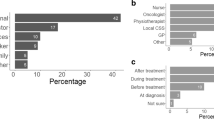Abstract
Our aim was to synthesise the existing empirical literature and theoretical perspectives on the physical activity (PA) promotion practices and determinants of cancer clinicians and health professionals. We conducted a narrative review of theory and evidence to develop practice recommendations for improving the promotion of PA to cancer patients. Surveyed health professionals were aware of many benefits of PA for their cancer patients, although only ~40 % promoted PA to selected cancer patients. Walking was the most commonly promoted form of PA, with this promoted to assist patients control their weight and cardiovascular health risk. Barriers to promotion of PA included lack of time and knowledge of PA and behaviour change skills. Health professionals appear interested in promoting PA to their cancer patients, yet encounter several barriers. Further research is warranted to assist health professionals improve their PA promotion. An adapted reflective-impulsive model of social behaviour shows promise for assisting health professionals overcome barriers and provides an evidence-based theoretical framework for improving communication with patients. Universities, hospitals and/or health-care accreditation organisations also have important roles to play in assisting health professionals improve their promotion of PA to patients.

Similar content being viewed by others
References
Brandes K, Linn AJ, Smit EG, van Weert JCM (2015) Patients’ reports of barriers to expressing concerns during cancer consultations. Patient Educ Couns 98(3):317–322. doi:10.1016/j.pec.2014.11.021
Damush TM, Perkins A, Miller K (2006) The implementation of an oncologist referred, exercise self-management program for older breast cancer survivors. Psycho-Oncology 15(10):884–890. doi:10.1002/pon.1020
Gagliardi AR, Faulkner G, Ciliska D, Hicks A (2015) Factors contributing to the effectiveness of physical activity counselling in primary care: a realist systematic review. Patient Educ Couns 98(4):412–419. doi:10.1016/j.pec.2014.11.020
Jones LW, Courneya KS, Fairey AS, Mackey JR (2004) Effects of an oncologist’s recommendation to exercise on self-reported exercise behavior in newly diagnosed breast cancer survivors: a single-blind, randomized controlled trial. Ann Behav Med 28(2):105–113
Jones LW, Courneya KS, Peddle C, Mackey JR (2005) Oncologists’ opinions towards recommending exercise to patients with cancer: a Canadian national survey. Support Care Cancer 13(11):929–937. doi:10.1007/s00520-005-0805-8
Karvinen KH, McGourty S, Parent T, Walker PR (2012) Physical activity promotion among oncology nurses. Cancer Nurs 35(3):E41–E48. doi:10.1097/NCC.0b013e31822d9081
Keogh JWL, MacLeod RD (2012) Body composition, physical fitness, functional performance, quality of life and fatigue benefits of exercise for prostate cancer patients: a systematic review. J Pain Symptom Manag 43(1):96–110. doi:10.1016/j.jpainsymman.2011.03.006
Keogh JWL, Patel A, MacLeod RD, Masters J (2013) Perceptions of physically active men with prostate cancer on the role of physical activity in maintaining their quality of life: possible influence of androgen deprivation therapy. Psycho-Oncology 22:2869–2875. doi:10.1002/pon.3363
Keogh JWL, Patel A, MacLeod RD, Masters J (2014) Perceived barriers and facilitators to physical activity in men with prostate cancer: possible influence of androgen deprivation therapy. Eur J Cancer Care (Engl) 23(2):263–273. doi:10.1111/ecc.12141
LeMasters TJ, Madhavan SS, Sambamoorthi U, Kurian S (2014) Health behaviors among breast, prostate, and colorectal cancer survivors: a US population-based case–control study, with comparisons by cancer type and gender. J Cancer Surviv 8(3):336–348. doi:10.1007/s11764-014-0347-5
Mishra SI, RW Scherer, PM Geigle, DR Berlanstein, O Topaloglu, CC Gotay, and C Snyder (2012) Exercise interventions on health‐related quality of life for cancer survivors. Cochrane Database Syst Rev 8. doi: 10.1002/14651858.CD007566.pub2.
Orrow G, Kinmonth A-L, Sanderson S, Sutton S (2012) Effectiveness of physical activity promotion based in primary care: systematic review and meta-analysis of randomised controlled trials. BMJ 344:e1389
Ottenbacher A, Sloane R, Snyder DC, Kraus W, Sprod L, Demark-Wahnefried W (2013) Cancer-specific concerns and physical activity among recently diagnosed breast and prostate cancer survivors. Integr Cancer Ther 12(3):206–212. doi:10.1177/1534735412449734
Pinto BM, Ciccolo JT (2011) Physical activity motivation and cancer survivorship. Recent Results Cancer Res 186:367–387. doi:10.1007/978-3-642-04231-7_16
Robertson L, Richards R, Egan R, Szymlek-Gay EA (2013) Promotion and support of physical activity among cancer survivors: a service provider perspective. Psycho-Oncology 22(2):441–446. doi:10.1002/pon.3032
Rock CL, Doyle C, Demark-Wahnefried W, Meyerhardt J, Courneya KS, Schwartz AL, Bandera EV et al (2012) Nutrition and physical activity guidelines for cancer survivors. CA Cancer J Clin 62(4):242–274. doi:10.3322/caac.21142
Schmitz KH, Speck RM, Rye SA, DiSipio T, Hayes SC (2012) Prevalence of breast cancer treatment sequelae over 6 years of follow-up. Cancer 118(S8):2217–2225. doi:10.1002/cncr.27474
Spellman C, Craike M, Livingston P (2014) Knowledge, attitudes and practices of clinicians in promoting physical activity to prostate cancer survivors. Health Educ J 73(5):566–575. doi:10.1177/0017896913508395
Stacey FG, James EL, Chapman K, Courneya KS, Lubans DR (2015) A systematic review and meta-analysis of social cognitive theory-based physical activity and/or nutrition behavior change interventions for cancer survivors. J Cancer Surviv 9(2):305–338. doi:10.1007/s11764-014-0413-z
Trikalinos TA, Wieland LS, Adam GP, Zgodic A, Ntzani EE (2014) AHRQ comparative effectiveness reviews. In: Decision aids for cancer screening and treatment. Agency for Healthcare Research and Quality (US), Rockville (MD)
Williams K, RJ Beeken, A Fisher, and J Wardle. in press. Health professionals’ provision of lifestyle advice in the oncology context in the United Kingdom. Eur J Cancer Care (Engl). doi: 10.1111/ecc.12305.
Wouda JC, van de Wiel HBM (2013) Education in patient–physician communication: how to improve effectiveness? Patient Educ Couns 90(1):46–53. doi:10.1016/j.pec.2012.09.005
Wouda JC, van de Wiel HBM (2014) The effects of self-assessment and supervisor feedback on residents’ patient-education competency using videoed outpatient consultations. Patient Educ Couns 97(1):59–66. doi:10.1016/j.pec.2014.05.023
Acknowledgments
We would like to thank Elizabeth Edwards from Bond University for her constructive criticisms on this manuscript prior to submission.
Conflict of Interest
The authors declare that they have no competing interests.
Author information
Authors and Affiliations
Corresponding author
Rights and permissions
About this article
Cite this article
Keogh, J.W., Olsen, A., Climstein, M. et al. Benefits and Barriers of Cancer Practitioners Discussing Physical Activity with their Cancer Patients. J Canc Educ 32, 11–15 (2017). https://doi.org/10.1007/s13187-015-0893-1
Published:
Issue Date:
DOI: https://doi.org/10.1007/s13187-015-0893-1




